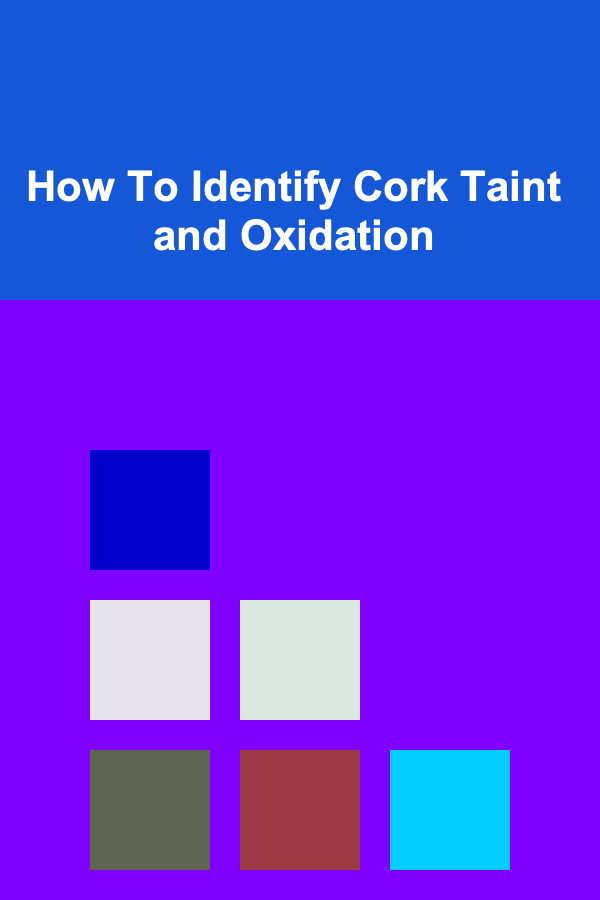
How To Identify Cork Taint and Oxidation
ebook include PDF & Audio bundle (Micro Guide)
$12.99$8.99
Limited Time Offer! Order within the next:

Cork taint and oxidation are two common issues in the world of wine that can significantly affect the quality and enjoyment of a bottle. Both are linked to chemical reactions that alter the characteristics of wine, often making it less enjoyable to drink. While these issues are distinct, they are often confused because both involve changes in a wine's flavor and aroma. In this article, we will delve deep into understanding cork taint and oxidation, how to identify each, and the impact they have on wine. Additionally, we will discuss ways to prevent or minimize these problems to ensure a better wine experience.
What is Cork Taint?
Cork taint refers to a wine fault caused by a chemical compound called TCA (2,4,6-trichloroanisole). TCA is a naturally occurring compound that can form when cork comes into contact with certain chemicals, particularly chlorine-based cleaning agents. These chemicals can trigger a reaction that leads to the production of TCA, which then leeches into the wine during the bottling process, creating the unpleasant "corked" flavor and aroma.
How Does Cork Taint Affect Wine?
When TCA is present in a bottle of wine, it can make the wine smell musty, moldy, or like wet cardboard. It can also cause the wine to lose its fruitiness and freshness. The aromas of corked wine are typically described as earthy, damp, and musty, masking the wine's true character. Affected wines may also taste dull, flat, or lifeless.
Interestingly, TCA is detectable at extremely low concentrations. Even as little as five parts per trillion (ppt) of TCA can make a wine undrinkable. This is why cork taint is such a problematic issue in the wine industry, as it is often hard to detect before the wine is opened.
How to Identify Cork Taint
Identifying cork taint in wine is primarily a matter of sniffing and tasting the wine. Here's what you should look for:
- Smell: The most noticeable indicator of cork taint is the presence of musty or damp aromas. You may smell wet cardboard, mold, or a damp basement. Sometimes, the musty aroma is faint, while in other cases, it is overwhelming. The fruit aromas in the wine will be muted or completely absent.
- Taste: If you don't notice the aroma immediately, the taste will often give it away. Corked wines taste dull, flat, or like they've lost their vibrancy. The fruit flavors will be muted, and the wine will have a strange, unpleasant aftertaste that lingers.
- Mouthfeel: While cork taint primarily affects aroma and flavor, some drinkers report that corked wines also have an odd, dry mouthfeel, making the wine feel a bit "off" in texture.
- Other Signs: In some cases, cork taint can be confirmed by looking at the cork itself. If the cork has visible mold, this can be an indicator that the wine inside is affected. However, mold on the cork doesn't always guarantee cork taint; it's just a sign that something went wrong in the bottling process.
Preventing Cork Taint
Cork taint can occur due to various reasons, but there are steps that can be taken to reduce its risk:
- Cork Quality: The use of high-quality corks in wine bottles is essential. Corks from reputable sources that are treated and tested for TCA contamination are less likely to result in tainted wine.
- Alternative Closure Types: Many wineries are moving away from corks in favor of screw caps or synthetic corks, which are less likely to harbor the TCA compound. These alternatives help mitigate the risk of cork taint.
- Proper Storage: Wines should be stored in proper conditions, including cool, dry, and dark places. If corks are exposed to excessive humidity, the risk of TCA contamination may increase.
What is Oxidation?
Oxidation is a natural process that occurs when wine is exposed to oxygen. While some level of oxidation is necessary in winemaking, excessive exposure to oxygen can cause significant deterioration in the wine's quality. In small amounts, oxidation can help soften tannins and develop complexity, but too much oxygen exposure can lead to a wine losing its freshness, color, and flavor.
Oxidation typically happens when wine is not sealed properly or when it has been open for too long. The process of oxidation can also be accelerated by high temperatures and poor storage conditions.
How Does Oxidation Affect Wine?
Oxidation changes the chemical composition of wine, particularly by affecting its polyphenols, which are responsible for its color, flavor, and aroma. The primary effects of oxidation include:
- Loss of Freshness: One of the most noticeable effects of oxidation is the loss of freshness. The wine can become dull and lifeless, with its once-vibrant fruit flavors fading.
- Color Change: Oxidation can also alter the color of the wine. Red wines may turn brown, while white wines can develop a golden or amber hue.
- Sherry-like Aroma: Oxidized wines can develop a nutty, sherry-like aroma, reminiscent of overripe fruit or even stale walnuts. These aromas are typically a sign of excessive oxidation.
- Flatness: Over time, oxidation reduces the wine's structure, making it taste flat. The wine may also lose its acidity, resulting in a less balanced and more boring drink.
How to Identify Oxidation
Oxidation is easier to identify than cork taint, as its effects are more noticeable in both aroma and flavor. Here's how to spot oxidized wine:
- Smell: An oxidized wine may have an off, stale smell, with aromas of overripe fruit, wet cardboard, or nuts. There might also be a sherry-like aroma that signals excessive oxygen exposure.
- Taste: Oxidized wines often taste flat and lifeless. The fresh fruit flavors fade, and the wine may have a bitter or sour taste. In extreme cases, the wine can taste like vinegar or have a sharp, off-putting tang.
- Color: If you're working with a white wine, look for a shift in color. Oxidation will cause the wine to take on a darker, golden, or brownish hue. Red wines will also show discoloration, shifting to a brownish tone instead of the expected vibrant red.
- Mouthfeel: Oxidized wines may feel more "thick" or "heavy" in the mouth, lacking the fresh acidity that normally balances the wine's texture.
Preventing Oxidation
To minimize oxidation, follow these guidelines:
- Proper Sealing: Always ensure that the wine bottle is properly sealed. For wines that are being stored for an extended period, consider using corks or closures that provide an airtight seal.
- Correct Storage: Store wines upright in a cool, dark place with consistent temperature. Avoid exposure to heat or direct sunlight, as this can hasten the oxidation process.
- Shorter Exposure to Air: Once opened, wine should be consumed within a reasonable timeframe. If the bottle is not finished, use a wine stopper to reduce its exposure to air and minimize oxidation.
Key Differences Between Cork Taint and Oxidation
Although cork taint and oxidation both result in undesirable changes to wine, they differ in several ways:
- Cause: Cork taint is caused by the chemical compound TCA, while oxidation is caused by excessive exposure to oxygen.
- Aroma and Flavor: Cork taint produces musty, moldy, and damp aromas, whereas oxidation leads to stale, nutty, or sherry-like aromas and flavors.
- Color: Oxidized wines may exhibit noticeable color changes, while corked wines typically do not.
- Treatment: There is no cure for cork taint once it has affected a wine; however, oxidation can sometimes be reversed by sealing the wine and reducing its exposure to air. However, this is often not entirely effective, especially for severe oxidation.
Conclusion
Both cork taint and oxidation are significant issues in the wine industry that can detract from a wine's quality. Cork taint, caused by the presence of TCA, results in musty, moldy aromas and dull flavors, while oxidation leads to flat, stale, and sometimes vinegar-like characteristics. The key to managing these issues lies in proper storage, handling, and sealing techniques, as well as awareness of how to identify each problem.
Cork taint, being nearly impossible to prevent entirely, remains a frustrating issue for both producers and consumers. On the other hand, oxidation can be largely avoided with proper storage practices and by reducing a wine's exposure to air. By understanding the causes and signs of these two wine faults, you can ensure a more enjoyable drinking experience and better appreciate the complexity of the wines you enjoy.

Beginner's Guide to Learning a New Language
Read More
Pet Care on a Budget: Smart Ways to Save While Keeping Your Pet Healthy
Read More
The Top 10 Passive Income Ideas Using Deep Learning
Read More
The Art and Science of Splitting Firewood: Mastering the Axe and Maul
Read More
How to Handle Q&A Sessions Like a Pro
Read More
10 Tips for Firing Raku Ceramics Safely
Read MoreOther Products

Beginner's Guide to Learning a New Language
Read More
Pet Care on a Budget: Smart Ways to Save While Keeping Your Pet Healthy
Read More
The Top 10 Passive Income Ideas Using Deep Learning
Read More
The Art and Science of Splitting Firewood: Mastering the Axe and Maul
Read More
How to Handle Q&A Sessions Like a Pro
Read More